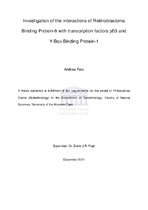| dc.description.abstract | Retinoblastoma Binding Protein 6 (RBBP6) is a 250 kDa multi-domain protein that
has been implicated in diverse cellular processes including apoptosis, mRNA processing and cell cycle regulation. Many of these functions are likely to be related
to its interaction with tumour suppressor proteins p53 and the Retinoblastoma
protein (pRb), and the oncogenic Y-Box Binding Protein-1 (YB-1). RBBP6 inhibits the
binding of p53 to DNA and enhances the HDM2-mediated ubiquitination and
proteasomal degradation of p53. Disruption of RBBP6 leads to an embryonic lethal
phenotype in mice as a result of widespread p53-mediated apoptosis. RBBP6
promotes ubiquitination and degradation of YB-1, leading to its proteasomal
degradation in vivo.The first part of this thesis describes in vitro investigations of the interaction betweenbacterially-expressed human p53 and fragments of human RBBP6 previously identified as interacting with p53, in an attempt to further localise the region of interaction on both proteins. GST-pull down assays and immunoprecipitation assays confirmed the interaction, and localised it to the core DNA binding domain of p53 and a region corresponding to residues 1422-1668 of RBBP6. However in Nuclear Magnetic Resonance (NMR) chemical shift perturbation assays no evidence was found for the interaction. NMR showed the relevant region of RBBP6 to be unfolded,and no evidence was found for interaction-induced folding. The R273H mutant of the p53 core domain did not abolish the interaction, in contrast to reports that the corresponding murine mutation (R270C) did abolish the interaction.The second part of this thesis describes in vitro investigations of the ubiquitination of YB-1 by RBBP6. A fragment corresponding to the first 335 residues of RBBP6,denoted R3, was expressed in bacteria and found to be soluble. Contrary to expectation, in a fully in vitro assay R3 was not able to ubiquitinate YB-1. However,following addition of human cell lysate, YB-1 was degraded in an R3-dependent and proteasome-dependent manner, indicating that R3 is required for ubiquitination and proteasomal degradation of YB-1. However R3 is not sufficient, with one or more factors being supplied by the cell lysate. In view of the pro-tumourigenic effects of YB-1 in many human cancers, these results lay the foundation for an understanding of the regulatory effect of RBBP6 on YB-1 and its potential role in anti-tumour therapy. | en_US |

